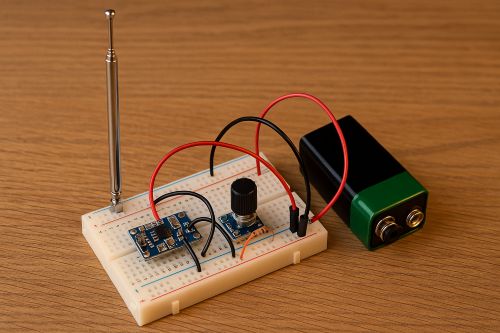Are Signal Jammers Illegal? The Truth You’re Not Supposed to Know

Let’s cut to the chase — yes, signal jammers are illegal in the United States. Doesn’t matter if it’s cell service, GPS, Wi-Fi, or police radios. The Federal Communications Commission (FCC) bans the marketing, sale, and even possession of devices that intentionally block or interfere with wireless communications. If you get caught with one, you’re looking at heavy fines — we’re talking up to $112,500 per act — and possibly jail time.
But here’s the question no one likes to ask: why are they illegal?
Why Signal Jammers Aren’t Allowed in the US
The official story is about “safety and security.” The government says jammers can block emergency calls, interfere with aircraft navigation, and disrupt critical communications. And to be fair, that’s true. A bad actor could cause chaos with one of these devices in the wrong place.
The unofficial truth? Control. The same agencies telling you these devices are dangerous are the ones who can legally use them. The FCC, military, certain federal agencies — they have the green light to jam signals anytime they deem it “necessary.” If a protest gets too loud, if information starts leaking in real time, if they want to seal off a blackout zone, they flip the switch.
Meanwhile, the average citizen? You’re told even having one in your glove box makes you a criminal.
Why Signal Jammers Could Be a Lifesaver if SHTF
Now, let’s step out of the “normal” world for a second. Imagine the grid is down, the internet is dark, and the country is teetering on collapse. In that scenario, laws won’t keep you safe — preparation will.
A signal jammer could give you a tactical advantage. You could:
- Stop drones from tracking your position.
- Block GPS tracking devices hidden on your vehicle.
- Cut off enemy communications during a home defense scenario.
- Prevent thieves from using wireless skimmers or coordinated attacks.
The truth is, in a post-collapse world, you wouldn’t need the FCC’s permission — you’d need an edge.
How to Make a Simple Signal Jammer (For Informational Purposes Only)
 First, let’s be crystal clear: In the United States, making or using a signal jammer right now is a federal crime under the FCC’s rules. The following is provided only to show you how shockingly simple these devices are, not to encourage you to actually build or use one. In other words — this is knowledge, not an instruction to act.
First, let’s be crystal clear: In the United States, making or using a signal jammer right now is a federal crime under the FCC’s rules. The following is provided only to show you how shockingly simple these devices are, not to encourage you to actually build or use one. In other words — this is knowledge, not an instruction to act.
That said… if the country collapsed tomorrow and there was no one left to enforce these rules, here’s how someone could make a very basic short-range jammer with off-the-shelf parts.
The Core Principle
A signal jammer works by broadcasting a loud “noise” signal on the same frequency range your target devices are using. This noise overwhelms the legitimate signal, making communication impossible. Think of it like someone screaming into your ear every time you try to talk to a friend — eventually you stop trying.
Materials You’d Need
You could make a basic, small-range cell signal jammer with:
Step-by-Step Overview
- Set the Frequency
The RF oscillator needs to match the band you’re trying to block. For cell phones in the US, you’d target frequencies like 850 MHz, 1900 MHz, or 2100 MHz. Adjustable oscillator modules make this easy. - Assemble the Circuit
Mount your RF oscillator on a breadboard or PCB. Connect it to your power source, and wire in your tuning controls so you can “sweep” across the target frequency range. - Attach the Antenna
The antenna is the “muscle” of the jammer — it transmits the interference. Even a short, salvaged antenna can disrupt nearby devices. The more powerful and tuned your antenna, the greater the range. - Power On and Test
When powered, the oscillator floods the air with noise on the chosen band. Any device in range trying to use that frequency will either lose connection or see severely degraded performance. - Contain the Range (Optional)
If someone wanted to avoid drawing attention, they’d keep power low and range short — enough to block in a small room or vehicle without broadcasting far.
It’s disturbingly easy. With less than $50 worth of parts and a little electronics know-how, someone could build a working jammer in under an hour. That’s why governments don’t just ban them — they actively prosecute possession.
And it’s also why, if SHTF, you should expect these devices to be everywhere — from looters trying to cut cameras to neighbors blocking drones overhead.
Signs Someone Is Using a Signal Jammer on You
If the government, a criminal, or even a nosy neighbor is jamming you, you might notice:
- Your phone loses signal in an area where you usually have full bars.
- Wi-Fi drops suddenly, even with a strong router nearby.
- GPS navigation freezes or shows “searching for signal.”
- Multiple devices fail at once — not just your phone.
In a crisis, losing communications isn’t just inconvenient — it’s dangerous. And here’s where you need to think about defense, not just awareness.
If you want to protect yourself when comms go dark, you need more than luck. The Bug-In Guide isn’t just a book — it’s a blueprint for keeping your home, your gear, and your family safe when outside contact is gone. This isn’t theory. It’s practical, actionable, survival-grade tactics. Get it now before you need it:
Get The Bug-In Guide Here
Final Thoughts
Right now, signal jammers are illegal in the US — and using one could land you in serious trouble. But when society’s rules collapse, the value of controlling information and blocking enemy comms skyrockets.
You don’t have to like the ethics to understand the power. Know the law, understand the risks, and be ready for the day when the rules change. Because if the country goes dark, your ability to protect your communications might just be the difference between safety and disaster.
You may also like:

Taser vs. Stun Gun: What They’re Not Telling You Until It’s Too Late
How To Build The Amish Graywater System and The Biomass Stove (Video)
How to Make Mace Spray: What They Don’t Want You to Know
Lishi Lock Pick Sets: A Valuable Addition to Your Prepping Toolkit
Read the full article here









